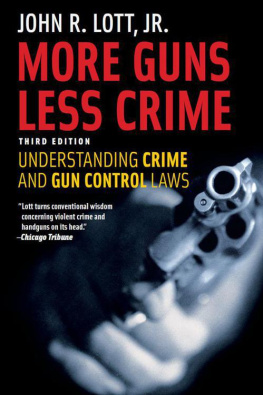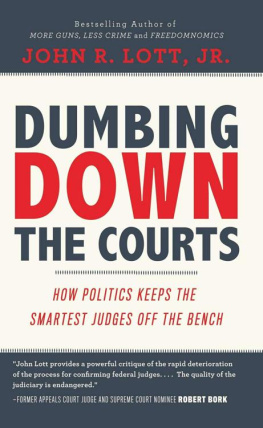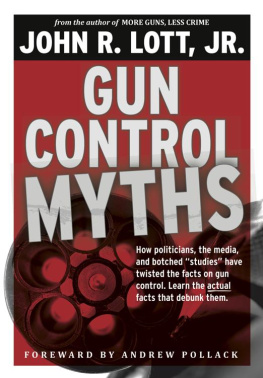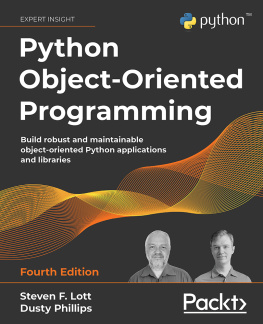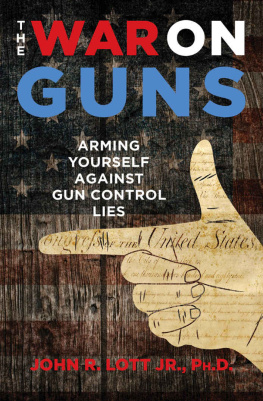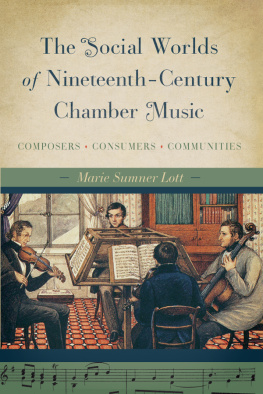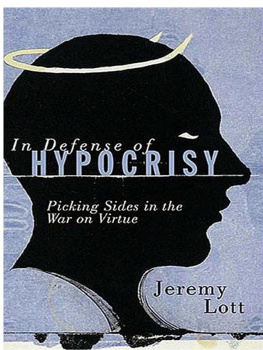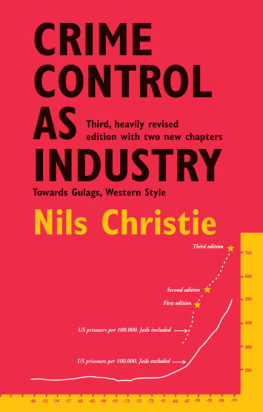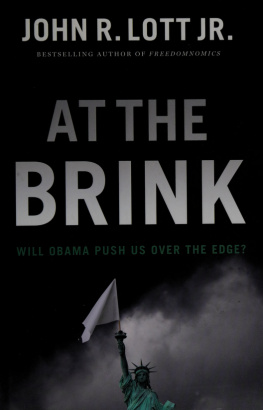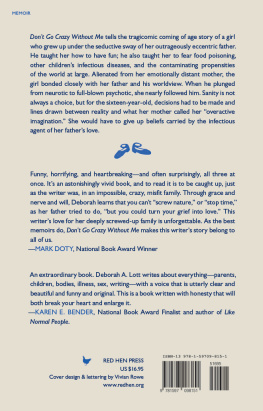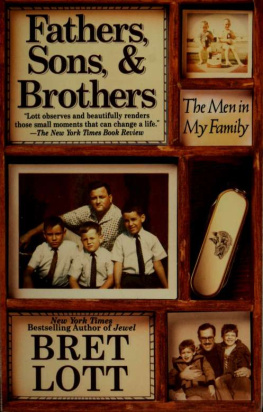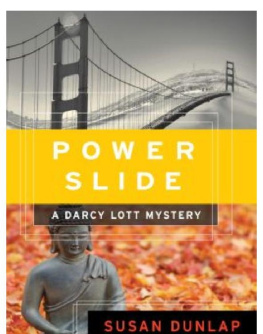John R. Lott Jr. - More Guns, Less Crime: Understanding Crime and Gun Control Laws, Third Edition
Here you can read online John R. Lott Jr. - More Guns, Less Crime: Understanding Crime and Gun Control Laws, Third Edition full text of the book (entire story) in english for free. Download pdf and epub, get meaning, cover and reviews about this ebook. year: 2010, publisher: University Of Chicago Press, genre: Politics. Description of the work, (preface) as well as reviews are available. Best literature library LitArk.com created for fans of good reading and offers a wide selection of genres:
Romance novel
Science fiction
Adventure
Detective
Science
History
Home and family
Prose
Art
Politics
Computer
Non-fiction
Religion
Business
Children
Humor
Choose a favorite category and find really read worthwhile books. Enjoy immersion in the world of imagination, feel the emotions of the characters or learn something new for yourself, make an fascinating discovery.
- Book:More Guns, Less Crime: Understanding Crime and Gun Control Laws, Third Edition
- Author:
- Publisher:University Of Chicago Press
- Genre:
- Year:2010
- Rating:3 / 5
- Favourites:Add to favourites
- Your mark:
- 60
- 1
- 2
- 3
- 4
- 5
More Guns, Less Crime: Understanding Crime and Gun Control Laws, Third Edition: summary, description and annotation
We offer to read an annotation, description, summary or preface (depends on what the author of the book "More Guns, Less Crime: Understanding Crime and Gun Control Laws, Third Edition" wrote himself). If you haven't found the necessary information about the book — write in the comments, we will try to find it.
John R. Lott, Jr., is the author five books, including Freedomnomics and Are Predatory Commitments Credible? Who Should the Courts Believe? , the latter also published by the University of Chicago Press.
John R. Lott Jr.: author's other books
Who wrote More Guns, Less Crime: Understanding Crime and Gun Control Laws, Third Edition? Find out the surname, the name of the author of the book and a list of all author's works by series.
More Guns, Less Crime: Understanding Crime and Gun Control Laws, Third Edition — read online for free the complete book (whole text) full work
Below is the text of the book, divided by pages. System saving the place of the last page read, allows you to conveniently read the book "More Guns, Less Crime: Understanding Crime and Gun Control Laws, Third Edition" online for free, without having to search again every time where you left off. Put a bookmark, and you can go to the page where you finished reading at any time.
Font size:
Interval:
Bookmark:
John R. Lott, Jr., is the author of five books, including Freedomnomics and Are Predatory Commitments Credible? Who Should the Courts Believe?
The University of Chicago Press, Chicago 60637
The University of Chicago Press, Ltd., London
1998, 2000, 2010 by The University of Chicago
All rights reserved. Published 2010
Printed in the United States of America
19 18 17 16 15 14 13 12 11 10 1 2 3 4 5
ISBN-13: 978-0-226-49366-4 (paper)
ISBN-10: 0-226-49366-0 (paper)
ISBN-13: 978-0-226-49367-1 (e-book)
Library of Congress Cataloging-in-Publication Data
Lott, John R.
More guns, less crime : understanding crime and gun-control laws / John R. Lott, Jr.3rd ed.
p. cm.Includes bibliographical references and index.
ISBN-13: 978-0-226-49366-4 (pbk. : alk. paper)
ISBN-10: 0-226-49366-0 (pbk. : alk. paper)
1. FirearmsLaw and legislationUnited States. 2. Firearms and crimeUnited States. I. Title.
KF3941.L68 2010
344.7305'33dc22
2009036622
 The paper used in this publication meets the minimum requirements of the American National Standard for Information SciencesPermanence of Paper for Printed Library Materials, ANSI Z39.48-1992.
The paper used in this publication meets the minimum requirements of the American National Standard for Information SciencesPermanence of Paper for Printed Library Materials, ANSI Z39.48-1992.
MORE GUNS, LESS CRIME
UNDERSTANDING CRIME AND GUN-CONTROL LAWS
THIRD EDITION
JOHN R. LOTT, JR.
THE UNIVERSITY OF CHICAGO PRESS
CHICAGO AND LONDON
Lott turns conventional wisdom concerning violent crime and handguns on its head. Chicago Tribune Books An intriguing and shocking look at crime, guns, and gun-control policy. Kirkus Reviews This book is a refreshing, well-documented case for responsible gun ownership. Bookviews For anyone with an open mind on either side of this subject this book will provide a thorough grounding. It is also likely to be the standard reference on the subject for years to come. Stan Liebowitz, Dallas Morning News John Lotts work to uncover the truth about the costs and benefits of guns in America is as valuable as it is provocative. Too much of todays public debate over gun ownership and laws ignores the empirical evidence. Based on carefully proven facts, Professor Lott shatters the orthodox thinking about guns and debunks the most prominent myths about gun use that dominate the policy debate. For those who are convinced that the truth matters in formulating public policy and for anyone interested in the role of guns in our society, More Guns, Less Crime is must reading. Edwin Meese III, U.S. Attorney General, 198588 More Guns, Less Crime is one of the most important books of our time. It provides thoroughly researched facts on a life-and-death subject that is too often discussed on the basis of unsubstantiated beliefs and hysterical emotions. Thomas Sowell Armed with reams of statistics, John Lott has documented many surprising linkages between guns and crime. More Guns, Less Crime demonstrates that what is at stake is not just the right to carry arms but rather our performance in controlling a diverse array of criminal behaviors. Perhaps most disturbing is Lotts documentation of the role of the media and academic commentators in distorting research findings that they regard as politically incorrect. W. Kip Viscusi, Cogan Professor of Law and Director of the Program on Empirical Legal Studies, Harvard Law School John Lott has done the most extensive, thorough, and sophisticated study we have on the effects of loosening gun control laws. Regardless of whether one agrees with his conclusions, his work is mandatory reading for anyone who is open-minded and serious about the gun control issue. Especially fascinating is his account of the often unscrupulous reactions to his research by gun control advocates, academic critics, and the news media. Gary Kleck, Professor of Criminology and Criminal Justice, Florida State University Until John Lott came along, the standard research paper on firearms and violence consisted of a longitudinal or cross-sectional study on a small and artfully selected data set with few meaningful statistical controls. Lotts work, embracing all of the data that are relevant to his analysis, has created a new standard, which future scholarship in this area, in order to be credible, will have to live up to. Dan Polsby, Kirkland & Ellis Professor of Law, Northwestern University His empirical analysis sets a standard that will be difficult to match.... This has got to be the most extensive empirical study of crime deterrence that has been done to date. Public Choice The most important book ever published about firearms policy.... [I] t should be read by everyone who cares about firearms policy, which is literally a matter of life or death.... [T]he more people who read More Guns, Less Crime , the sooner streets in every state will become safe zones for good citizens, rather than for predators. David B. Kopel, Chronicles Lott impressively marshals the evidence in support of his position in his best-selling (for an academic book) More Guns, Less Crime . As a result, Lott has become one of the few members of the legal academy whose name is now bandied about on talk shows, in legislative sessions, and in the print media.... [F]or those who argue that the serious evaluation of data is an important and underutilized guide to good public policy, this book poses a real challenge. For make no mistake, Lott has painstakingly constructed a massive data set, analyzed it exhaustively, and commendably shared it with scholars across the country. In these respects, he deserves high praise for following the scientific protocol so faithfully. Ian Ayres and John J. Donohue III, American Law and Economics ReviewCONTENTS
PREFACE TO THE THIRD EDITION
Ten years have passed since the last edition of this book. Much has happened in those years. Now thirty-nine states have right-to-carry laws, a huge increase from the eighteen states with them when David Mustard and I first examined the relationship between such laws and crime. That original research in this book covered the sixteen years from 1977 through 1992. The second edition extended it by four years and covered twenty-eight states. Now, this new edition covers thirty-nine states and twenty-nine years from 1977 through 2005. That is a lot of crime data to study, especially with so many more states having adopted the law during the time.
By now, dozens of academics have published studies on right-to-carry laws using national data. These studies have either confirmed the beneficial link between gun ownership and crime or at least not found any indication that ownership increases crime. Not too surprisingly, depending on the precise methods used and the exact data set, the results have varied. Some claim no effect from these laws, but not a single refereed study finds the opposite result, that right-to-carry laws have a bad effect on crime.
Unfortunately, even normally level-headed scholars can get very emotional debating guns. Perhaps I am naive, but I have continued to be amazed by the great lengths people can go to attack others and to distort research. I had no idea of the political intensity of the gun issue when I entered into this hornets nest.
Right-to-carry laws are still the focus of this new edition, but I will address questions about some new laws as well. One of them is the Castle Doctrine, which states that it is not necessary for a would-be victim to retreat as far as possible before using a gun defensively. The federal assault weapons ban will also be studied. The federal assault weapons ban started in 1994 but ended in 2004. Rarely do we get a chance to look at the impact of gun laws when they are first passed and then when they are eliminated.
Not only have laws changed, but also the Supreme Court has ruled on important gun rights cases. A case of possible historic significance was the Supreme Court striking down the DC handgun ban in June 2008. The handgun ban in Chicago is currently being challenged in the courts, and it is possible that the Supreme Court will review that case also. Since the DC ruling, there has been a lot of renewed interest in the impact of gun bans on crime and suicide rates, and those same questions will be brought up again when deciding whether the Second Amendment applies to states as well as to areas controlled by the federal government, such DC.
Next pageFont size:
Interval:
Bookmark:
Similar books «More Guns, Less Crime: Understanding Crime and Gun Control Laws, Third Edition»
Look at similar books to More Guns, Less Crime: Understanding Crime and Gun Control Laws, Third Edition. We have selected literature similar in name and meaning in the hope of providing readers with more options to find new, interesting, not yet read works.
Discussion, reviews of the book More Guns, Less Crime: Understanding Crime and Gun Control Laws, Third Edition and just readers' own opinions. Leave your comments, write what you think about the work, its meaning or the main characters. Specify what exactly you liked and what you didn't like, and why you think so.

